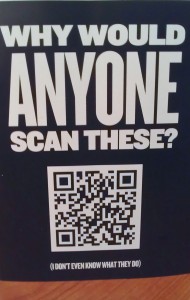 In addition to its tasty sandwiches, one of the distinctive qualities of Jimmy John’s Gourmet Sandwiches is its colorful listing of pithy, hilarious and, yes, even borderline crude comments.
In addition to its tasty sandwiches, one of the distinctive qualities of Jimmy John’s Gourmet Sandwiches is its colorful listing of pithy, hilarious and, yes, even borderline crude comments.
For instance, who doesn’t enjoy reading those rules to live by, such as this one: “Flipping burgers is not beneath your dignity. Your grandparents had a different word for burger flipping. They called it ‘opportunity.’”
(To assign proper credit, that list is by author Charles Sykes.)
In addition to that feature on the restaurant’s walls, a tabletop tent with a QR code is another eye-catching element.
Above the code is the question, “WHY WOULD ANYONE SCAN THESE?” Of course, “anyone” was extra large, to dare the reader to do just that very thing. Below the code, in smaller print, is the statement, “I don’t even know what they do.”
At this point, the world could be said to be divided into two groups: those who “get” QR codes, and those who don’t. In its message, Jimmy John’s is slyly speaking to both of those audiences.
First, there is the audience who “gets” QR codes and therefore is prone to scan them so they can check out where it will take them online, or whatever information it imparts—in this case, a blog with some humorous images and captions. This group is unlikely to be put off by the question, because they recognize that they are the “anyone” being implied.
They already know why someone would scan them—and Jimmy John’s is being coy by using a kind of “curiosity approach” to get them to do it themselves. This style of communication is an effective way to indirectly call people to action, while not being overbearing. By arousing curiosity, and leaving the ball in the court of the audience, the communicator is allowing the individual to respond, or not, based on his own preferences and tastes.
On the public relations and marketing front, in approaching the media with a story pitch, especially when uncertain if a given reporter might be interested in the topic, it’s advisable to soft-peddle a story before treading more aggressively.
As for those who are unfamiliar with QR codes, the Jimmy John’s copy acknowledges and might even be seen as validating their in-the-dark status. No harm done, and if anything, this type of consumer is prone to appreciate that Jimmy John’s “gets” them and accepts them wherever they may be along the technological curve.
By straddling these two divergent groups–speaking to them and acknowledging each in their own particular space–Jimmy John’s demonstrates its skill in artful communication.
